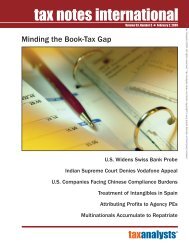deal structure note - Tuck School of Business - Dartmouth College
deal structure note - Tuck School of Business - Dartmouth College
deal structure note - Tuck School of Business - Dartmouth College
Create successful ePaper yourself
Turn your PDF publications into a flip-book with our unique Google optimized e-Paper software.
4<br />
Deal Structures Note<br />
Convertible preferred stock provides its owner with the right to convert to common<br />
shares <strong>of</strong> stock. Usually, preferred stock has certain rights that common stock does not<br />
have, such as a specified dividend that normally accrues and senior priority in receiving<br />
proceeds from a sale or liquidation <strong>of</strong> the company. Therefore, it provides downside<br />
protection due to its negotiated rights and allows investors to pr<strong>of</strong>it from share<br />
appreciation through conversion. The face value <strong>of</strong> preferred stock is generally equal to<br />
the amount that the VC invested. For accounting purposes, convertible stock is usually<br />
regarded as a common stock equivalent and is treated as such in valuing a company.<br />
Typically, convertible preferred stock automatically converts to common stock if the<br />
company makes an initial public <strong>of</strong>fering (IPO). When an investment banking<br />
underwriter is preparing a company to go public, it is critical that all preferred investors<br />
agree to convert so the underwriter can show public investors that the company has a<br />
clean balance sheet. Convertible preferred is the most common tool for private equity<br />
funds to invest in companies.<br />
EXAMPLE<br />
In the example above, suppose that the Series A investor receives convertible preferred<br />
stock with senior priority in receiving all proceeds from sale or liquidation, up to the<br />
original investment amount ($2 million).<br />
Owners/Investors Security Shares Investment<br />
Founders Common 6,000,000 $50,000<br />
A Convertible preferred 4,000,000 $2,000,000<br />
Now, if the company were sold for $4 million, the Series A investor would choose not to<br />
convert his shares to common and would receive:<br />
Proceeds to Series A = $2,000,000 (original investment)<br />
Proceeds to founders = $4,000,000 (sale price) - $2,000,000 (to Series A) = $2,000,000<br />
When would a holder <strong>of</strong> convertible preferred stock choose not to convert?<br />
If the company were sold for $5 million, then the Series A investor would be indifferent<br />
to converting. He would receive $2,000,000 (40% <strong>of</strong> $5 million) through conversion to<br />
common or as shown above. At a sale price above $5 million, the VC would choose to<br />
convert.<br />
Participating preferred stock is a unit <strong>of</strong> ownership that is essentially composed <strong>of</strong> two<br />
elements -- preferred stock and common stock. The preferred stock element entitles an

















